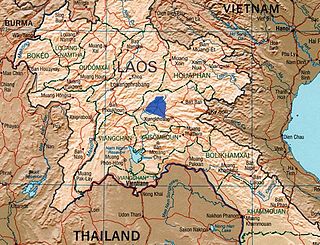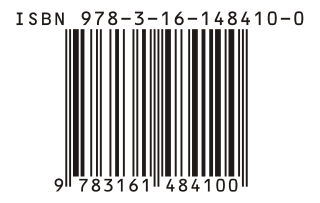
Captain Kong Le was a paratrooper in the Royal Lao Army. He led the premier unit of the Royal Lao Army, Bataillon Parachutistes 2, which campaigned relentlessly during 1959 and 1960. The idealistic young American-trained Lao Theung officer became known worldwide when on 10 August 1960 he and his mutinous paratroopers overthrew the Royal Lao Government in a coup d'état. He declared he aimed at an end to government corruption; to the shock of American officials, he declared U.S. policies were responsible for the ongoing fraud.
Operation Barrel Roll was a covert U.S. Air Force 2nd Air Division and U.S. Navy Task Force 77, interdiction and close air support campaign conducted in the Kingdom of Laos between 14 December 1964 and 29 March 1973 concurrent with the Vietnam War.
Operation Triangle was a military operation of the Laotian Civil War staged from 19—29 July 1964. Although planned by the General Staff of the Royal Lao Army, it was subject to American approval because the RLA depended on the Americans for finances, supplies, and munitions. Operation Triangle was an ambitious undertaking dependent on martial skills unfamiliar to the Lao. It not only called for coordination of infantry, artillery, and tactical air strikes among forces of three different nationalities; as a covert operation, it also had to have plausible deniability.
Operation Pigfat was a crucial guerrilla offensive of the Laotian Civil War; it lasted from 26 November 1968 to 7 January 1969. Launched by Hmong tribal soldiers backed by the Central Intelligence Agency, it was based on the usage of overwhelming air power to clear the path for the guerrillas. The guerrillas were faced with the largest concentration of Vietnamese communist troops stationed outside Vietnam, and hoped to spoil that imminent attack.
Campaign Toan Thang was the first communist wet season offensive of the Laotian Civil War. Launched on 18 June 1969 and successful by the 27th, the assault by People's Army of Vietnam troops from the 312th Division and sappers of the 13th Dac Cong Battalion captured Muang Soui. Although the defenders outnumbered the assailants by three to one, the only hard surfaced airfield near the Plain of Jars would fall to the communists, depriving the defending Royal Lao Government of its only forward fighter-bomber base.
Operation Off Balance was a hastily planned offensive operation of the Laotian Civil War; it happened between 1 and 15 July 1969 on the Plain of Jars in the Kingdom of Laos. The Royal Lao Government forces in Military Region 1 of Laos had just been evicted from the crucial all-weather airfield at Muang Soui, as well as most of the Plain, on 28 June 1969. Hmong General Vang Pao planned a quick counter-offensive to recapture the airfield from his communist foe; it would kick off on 1 July, supported by 60 sorties per day of tactical air strikes from Operation Barrel Roll.
The Battle of Ban Pa Dong was fought between 31 January and 6 June 1961 in Ban Pa Dong, the Kingdom of Laos. Troops from the People's Army of Vietnam (PAVN) and the Pathet Lao attacked Hmong recruits being trained as Auto Defense Choc guerrillas via Operation Momentum. Although the Hmong made the tactical error of defending a fixed position, their eventual escape from the communist invaders left their fledgling L'Armee Clandestine intact and able to wage war for the Royal Lao Government. However, they abandoned four howitzers and two mortars to the victorious Vietnamese communists. The partisans had also set a deleterious precedent for themselves with their defense of a fixed position.
Forces Armées Neutralistes was an armed political movement of the Laotian Civil War. Founded upon the basis of the mutinous Bataillon Parachustistes 2 that lost the Battle of Vientiane, FAN's original stance was that of its commander, Captain Kong Le, who espoused strict neutrality for the Kingdom of Laos and an end to governmental corruption. Withdrawing from Vientiane in defeat on 16 December 1960, FAN occupied the Plain of Jars; their major center was the all-weather airstrip at Muang Soui. The following year was spent in conflict with Royalist guerrillas. During 1961, FAN grew to a strength of 8,000; it had a company of tanks and a small air arm. However, it was hampered by inadequate supplies erratically passed along by the Pathet Lao communists.
Kou Kiet was a major Laotian Civil War victory for the anti-communist troops of the Kingdom of Laos. Patterned after prior Operation Raindance, it depended upon extensive air strikes blasting communist units and clearing them from the path of the Royalist offensive. Powered by 150 daylight and 50 night sorties daily, with 50 to 80 day strikes directed by Raven Forward Air Controllers, Kou Kiet ran from 6 August to 30 September 1969. It was successful beyond expectations. After the Royal Lao Government troops achieved their objectives, General Vang Pao insisted on pushing forward while they had the initiative. As a result, the Royalists regained control of the entire Plain of Jars while also capturing a huge stock of munitions from the communists. Their triumph came at a cost. However successful the Royalists were, by battle's end their battle-worn forces had exhausted their pool of potential recruits, while the Vietnamese could easily replace their personnel losses.

Muang Soui is a small town in Xiangkhouang Province in northeastern Laos. It is located along Route 7, northwest of Phonsavan.
Operation Junction City Jr. was a major Laotian offensive of the Vietnam War; initially aimed at temporary disruption of the Ho Chi Minh Trail, it was extended into an attempt to isolate the major North Vietnamese communist transshipment point at Tchepone from the units it was supposed to supply.
Campaign 139 was a major military offensive of the People's Army of Vietnam, launched against its Royalist enemies during the Laotian Civil War. Larger than previous invading forces, Campaign 139 was also a combined arms expedition containing tanks, artillery, engineers, and Dac Cong sappers. As such, it was a decided escalation in the war. It was also an exceptional rainy season offensive by PAVN, which usually withdrew during the wet season.
Operation Counterpunch, waged 26 September 1970 to 7 January 1971, was a military offensive of the Laotian Civil War. Royalist General Vang Pao's guerrilla army regained the vital all-weather forward fighter base at Muang Soui on the Plain of Jars from the People's Army of Vietnam (PAVN). The preemptive Counterpunch was credited with delaying an imminent PAVN wet season offensive for a month. The guerrilla army survived, though still heavily outnumbered by the PAVN.

Campaign 74B was a major combined arms offensive by the People's Army of Vietnam (PAVN) during the Laotian Civil War. The Communist offensive, if successful, would knock the last remaining fighting troops of the Kingdom of Laos out of the war, ensuring the Vietnamese conquest of Laos. The 316th PAVN Division—reinforced by artillery, tanks, and sappers—attacked during a period of slackened tactical air support for General Vang Pao's guerrilla army; Operation Lam Son 719 was being waged at the same time. Having captured the highly strategic Plain of Jars during Operation 74B, the Communists attackers managed to penetrate deeply enough to fire upon the main guerrilla base at Long Tieng.

Campaign Z was a military offensive by the People's Army of Vietnam; it was a combined arms thrust designed to defeat the last Royal Lao Army troops defending the Kingdom of Laos. The Communist assault took Skyline Ridge overlooking the vital Royalist base of Long Tieng and forced restationing of Royalist aviation assets and civilian refugees. However, Communist forces eventually receded back onto their lines of communication without capturing the base.
Operation Phou Phiang II was one of the final battles of the Laotian Civil War. It was an attempt to relieve the siege on the guerrilla headquarters at Long Tieng on the Plain of Jars. Planned with the backing of Henry Kissinger, it was designed as a two phase attack consisting of five task forces of Thai mercenaries and Royalist guerrillas upon the People's Army of Vietnam invading Laos. Air superiority was used to direct over 100 air strike sorties daily to support the offense, and air mobility to shuffle attacking troops. A new radar bombing program by F-111 Aardvarks and B-52 Stratofortresses failed to cripple the Communist forces. Designed to overwhelm Communist defenses with its multiplicity, the five Lao task forces were defeated in detail by the Communists despite two new columns being improvised and introduced into the fray.
Operation Phou Phiang III was the final offensive of the Laotian Civil War by the Royal Lao Army's L'Armée Clandestine. Central Intelligence Agency-sponsored Hmong guerrillas and Thai mercenaries formed three attacking task forces in an attempt to clear the People's Army of Vietnam from positions near the Royalist guerrillas' headquarters on the Plain of Jars. All three columns failed to move the Vietnamese invaders before the ceasefire of 21 February 1973 ended the war.
The Battles of Nakhang were fought between Royalist forces and North Vietnamese invaders for control of the northern base of Nakhang, Laos. The Lima Site 36 airstrip at Nakhang was capable of handling aircraft up to the size of C-123 cargo carriers; its location and length made it a vital component of the Royalist defense. Lima Site 36 was the airhead for their guerrillas' movements and resupply, as well as a staging point for U.S. combat search and rescue helicopters.
The Battles of Bouamlong came about because the valley of Bouamlong was a center of Royalist guerrilla operations during the Laotian Civil War. Located well into Communist-held territory and maintained by an air bridge, on several occasions Bouamlong served as a launching point for Royalist offensives such as Operation Raindance, Kou Kiet, Operation Counterpunch III, and Operation Strength. It was also targeted for attack by offensives by the People's Army of Vietnam during Campaign 139 and Campaign 74B. Defended by Auto Defense Choc troops led by Major Cher Pao Moua, Bouamlong held out against the Communist forces even after the War ended in a ceasefire in February 1973. There were reports of resistance into the 1990s.
Unity was the code name for Thailand's covert supply of mercenary soldiers to the Kingdom of Laos during the Laotian Civil War. From 4 July 1964 until March 1973, battalions of Thai volunteers fought Communist insurgents on the Plain of Jars in Military Region 2. As the Hmong L'Armée Clandestine was sapped by ongoing casualties and a limited basis for replacements, Unity battalions replaced them.





